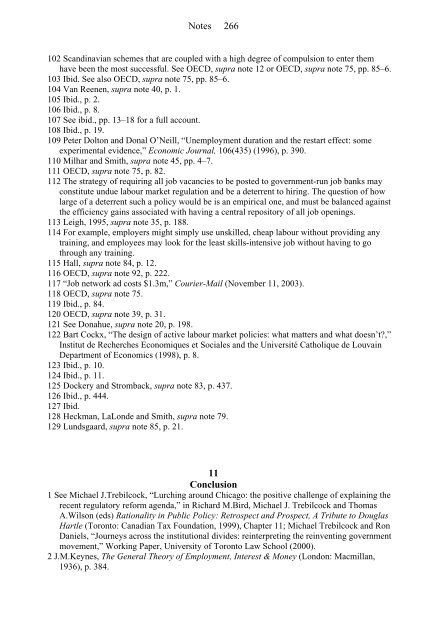Rethinking the Welfare State: The prospects for ... - e-Library
Rethinking the Welfare State: The prospects for ... - e-Library
Rethinking the Welfare State: The prospects for ... - e-Library
You also want an ePaper? Increase the reach of your titles
YUMPU automatically turns print PDFs into web optimized ePapers that Google loves.
Notes 266<br />
102 Scandinavian schemes that are coupled with a high degree of compulsion to enter <strong>the</strong>m<br />
have been <strong>the</strong> most successful. See OECD, supra note 12 or OECD, supra note 75, pp. 85–6.<br />
103 Ibid. See also OECD, supra note 75, pp. 85–6.<br />
104 Van Reenen, supra note 40, p. 1.<br />
105 Ibid., p. 2.<br />
106 Ibid., p. 8.<br />
107 See ibid., pp. 13–18 <strong>for</strong> a full account.<br />
108 Ibid., p. 19.<br />
109 Peter Dolton and Donal O’Neill, “Unemployment duration and <strong>the</strong> restart effect: some<br />
experimental evidence,” Economic Journal, 106(435) (1996), p. 390.<br />
110 Milhar and Smith, supra note 45, pp. 4–7.<br />
111 OECD, supra note 75, p. 82.<br />
112 <strong>The</strong> strategy of requiring all job vacancies to be posted to government-run job banks may<br />
constitute undue labour market regulation and be a deterrent to hiring. <strong>The</strong> question of how<br />
large of a deterrent such a policy would be is an empirical one, and must be balanced against<br />
<strong>the</strong> efficiency gains associated with having a central repository of all job openings.<br />
113 Leigh, 1995, supra note 35, p. 188.<br />
114 For example, employers might simply use unskilled, cheap labour without providing any<br />
training, and employees may look <strong>for</strong> <strong>the</strong> least skills-intensive job without having to go<br />
through any training.<br />
115 Hall, supra note 84, p. 12.<br />
116 OECD, supra note 92, p. 222.<br />
117 “Job network ad costs $1.3m,” Courier-Mail (November 11, 2003).<br />
118 OECD, supra note 75.<br />
119 Ibid., p. 84.<br />
120 OECD, supra note 39, p. 31.<br />
121 See Donahue, supra note 20, p. 198.<br />
122 Bart Cockx, “<strong>The</strong> design of active labour market policies: what matters and what doesn’t?,”<br />
Institut de Recherches Economiques et Sociales and <strong>the</strong> Université Catholique de Louvain<br />
Department of Economics (1998), p. 8.<br />
123 Ibid., p. 10.<br />
124 Ibid., p. 11.<br />
125 Dockery and Stromback, supra note 83, p. 437.<br />
126 Ibid., p. 444.<br />
127 Ibid.<br />
128 Heckman, LaLonde and Smith, supra note 79.<br />
129 Lundsgaard, supra note 85, p. 21.<br />
11<br />
Conclusion<br />
1 See Michael J.Trebilcock, “Lurching around Chicago: <strong>the</strong> positive challenge of explaining <strong>the</strong><br />
recent regulatory re<strong>for</strong>m agenda,” in Richard M.Bird, Michael J. Trebilcock and Thomas<br />
A.Wilson (eds) Rationality in Public Policy: Retrospect and Prospect, A Tribute to Douglas<br />
Hartle (Toronto: Canadian Tax Foundation, 1999), Chapter 11; Michael Trebilcock and Ron<br />
Daniels, “Journeys across <strong>the</strong> institutional divides: reinterpreting <strong>the</strong> reinventing government<br />
movement,” Working Paper, University of Toronto Law School (2000).<br />
2 J.M.Keynes, <strong>The</strong> General <strong>The</strong>ory of Employment, Interest & Money (London: Macmillan,<br />
1936), p. 384.


